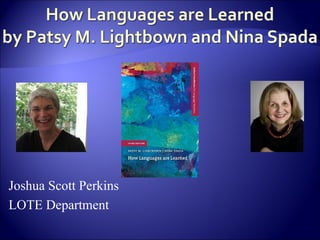
How Languages are Learned
- 1. Joshua Scott Perkins LOTE Department
- 2. children do not merely imitate what they hear but produce original language creatively grammatical morphemes are learned in sequence —e.g. 1) plural –s; 2) irregular past forms; 3) possessive 's; etc. Interrogatives develop sequentially as well: “what,” “where” and “who” first; “why,” “how” and “when” develop once the child’s mind matures cognitively
- 3. by age 4 children have mastered the basic structures of the language or languages spoken to them in these early years metalinguistic awareness develops in pre-school years leading to word ambiguity giving children access to word jokes, trick questions, and riddles during school years, the child’s vocabulary increases from several hundred to several thousand words a year aided by reading a variety of texts
- 4. in early school years, children begin to understand difference in language registers
- 5. behaviourism- B.F.Skinner states that children learn by imitation and practice innatist perspective- Noam Chomsky argues that a child’s ability to learn language is innate and that all children possess a universal grammar critical period hypothesis- suggests that humans are genetically programmed to acquire certain kinds of knowledge and skills at specific times —i.e. language
- 6. interactionist/developmental perspectives Piaget describes language as a symbol system used to express knowledge via interaction with the physical world Vygotsky proposes that speech emerges in social interactions both scientists agree that interaction between a language learner and an interlocutor is essential for language development connectionism- suggests that language acquisition is related to objects/images
- 7. bilingualism- little research supports that learning languages simultaneously produces a learning delay contrastive analysis hypothesis- states where L1 and L2 are similar, learners should attain L2 with ease connectionist propose that language is learned in chunks based on connections with the learner’s environment interaction hypothesis- learner interacts with interlocutor who uses modified speech to scaffold learning thus facilitating acquisition
- 8. high intelligence (I. Q.) does not directly correlate with a learner’s ability to acquire language language aptitude plays a role in acquisition independent of cognitive, social, and personality characteristics often associated with successful learning learning styles- visual, aural, and kinesthetic may affect language learning motivation and attitude- if the language is needed in everyday life then the learner is more motivated to learn
- 9. Research suggests that the earlier that language learners begin study—before 15 is ideal—and most often exposed translate to better fluency. That is, it appears that older learners are at a disadvantage compared to child or adolescent learners thus confirming Chomsky’s Critical Period Hypothesis. phonology- if L1 is more distant from L2 then pronunciation mastery will be more difficult Much of language learning is acquired according to developmental sequences; and, therefore, language taught beyond the learner’s current level will not be acquired.
- 10. Approaches that integrate attention to form within communicative and content-based interaction receive the most support from classroom research. Correcting grammatical mistakes does not significantly affect L1 acquisition. L2 learners, however, do need error correction to avoid fossilized incorrect forms. The best predictor of success in second language acquisition is motivation; though even these learners faces challenges.
- 11. The earlier a second language is introduced in school programs, the greater likelihood of success in learning. A good native language foundation in literacy is key to mastery of a second language. The best way to learn new vocabulary is through reading. This is true for native language. For second language, the learner must know 90% or more of the text for context to clarify meaning. Therefore, L2 readers need additional resources to aid acquisition. The ability to reproduce the phrasing and stress patterns are more important that the ability to articulate each sound of a language.
- 12. Learners need roughly 1,000 words and the basic structure of a second language to participate in conversations with native speakers. No matter how language is presented to learners, certain structures are acquired before others (simple or complex); frequent exposure to language forms aids acquisition. Errors are a natural part of language learning in L1 and L2. Form focused instruction with feedback appears to be the best method for improvement.
- 13. Language structures develop sequentially. There is a critical period of language learning ending at puberty. After this time, it becomes difficult to learn language fluently. Motivation in a learner is the principal factor for success. Aptitude plays a more important role than intelligence in language acquisition. Real world applicability of the language studied plays an important role in acquisition.
- 14. Lightbown, Patsy M. and Nina Spada. How Languages are Learned. 3rd ed. Oxford University Press, 2006. Print.
Editor's Notes
- 4) Copula “be”; 5) articles “the” and “a”; 6) regular past –ed; 7) third person singular simple present –s (runs); 8) auxiliary be (He is coming)
- Metalinguistic awareness is the ability to treat language as an object separate from the meaning it conveys
- Registers-written vs. spoken language; speech to principal vs. to friends; science report vs. literary narrative and regional/ethnic dialects
- Children do imitate, but their imitations are original creations and not just repetitions of what is heard; universal grammar allows the child to make sense of his/her language system; according to Chomsky’s critical period hypothesis, the period for learning language fluently ends at puberty
- Contrastive analysis hypothesis is not an adequate theory currently; research suggests that the interaction hypothesis is valid
- Motivation in the classroom-varying activities, tasks, and materials; using cooperative rather than competitive goals
- Language develops in sequences that take time to master—i.e. question acquisition, relative clause position, etc.
- One to two hours a week—even for seven to eight years—will NOT produce advanced second language speakers
- In order to communicate successfully, the learner must also possess knowledge of the pragmatic features of the language—show respect, apologize, or make requests—otherwise communication will breakdown.
